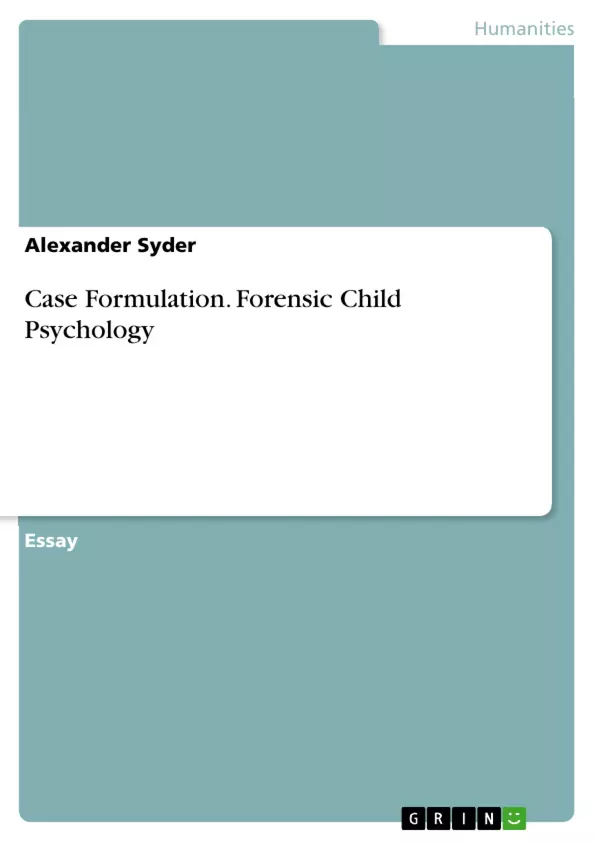Formulation can be defined as the process of constructing a hypothesis or “best guess” about the origins of a person’s difficulties in the context of their relationships, social circumstances, life events, and the sense that they have made of them. It provides a structure for thinking together with the client or service user about how to understand their experience(s) and how to move forward. The presentation of the case formulation will be conducted in accordance with the categories for consideration outlined in Weerasekara (1996) as follows: presenting issues; predisposing factors; precipitating factors; perpetuating factors and protective factors. These provide a clear comprehensive structure for reporting on the static, dynamic and contextual factors that may affect Tom’s behaviour and subsequent offending related judgements. The theoretical underpinning of the case formulation will be in accordance with the biopsychosocial model of psychological understanding. Metz (2005) provided a series of key recommendation(s) to the American Psychiatric Association (APA) commission on psychotherapy concerning the definition of the biopsychosocial model, which he comprehensively defined:
‘A biopsychosocial formulation is a tentative working hypothesis developed collaboratively with the child and family, which attempts to explain the biological, psychological and sociocultural factors which have combined to create and maintain the presenting clinical concern and which support the child’s best functioning… It will be changed, modified or amplified as the clinician and family learn more and more about the strengths and needs of the child and family’.
Inhaltsverzeichnis (Table of Contents)
- Tom's Presenting Issues
- Tom's predisposing (background) factors
- Tom's precipitating factors (triggers)
- Tom's perpetuating (maintaining) factors
- Tom's protective factors (strengths)
- Risk Assessment Instrument/Case Formulation
Zielsetzung und Themenschwerpunkte (Objectives and Key Themes)
This document aims to provide a case formulation of Tom's presenting issues and risk factors for violent behaviour. It explores the underlying causes of his behaviour, incorporating the biopsychosocial model and utilizing the Structured Assessment of Violence Risk in Youth (SAVRY) instrument.
- Biopsychosocial Model and its application to case formulation
- Identifying and evaluating risk and protective factors contributing to Tom's behaviour
- Assessing the impact of family dynamics, trauma history, and social environment
- Utilizing the SAVRY instrument for comprehensive risk assessment
- Considering the implications of Tom's age and potential developmental issues
Zusammenfassung der Kapitel (Chapter Summaries)
- Tom's Presenting Issues: This section details Tom's presenting behaviours, including shyness, withdrawal, and a paternalistic attitude towards his mother and sister. It also discusses his violent attack on his stepfather, which he attributes to fears for his family's safety. The section highlights concerns about potential physical abuse and child sex abuse (CSA).
- Tom's Predisposing Factors: This section explores Tom's background, emphasizing the chaotic family environment marked by violence and his mother's mental health struggles. It also delves into his early parental loss and its potential impact on his attachment style.
- Tom's Precipitating Factors: This section focuses on the immediate events that triggered Tom's violent act, highlighting the interpersonal conflict between his mother and stepfather and his perception of his family being threatened. It connects this event to his maladaptive paternalistic mentality.
- Tom's Perpetuating Factors: This section examines factors that maintain Tom's current behaviour, such as his preoccupation with his family, lack of engagement with peers, and exposure to domestic violence. It emphasizes the impact of a hostile environment on his school performance and social development.
- Tom's Protective Factors: This section highlights Tom's positive traits, such as his altruism, sense of responsibility, and potential coping mechanisms for stress. It acknowledges his protective role towards his family and explores his developing sense of masculinity.
Schlüsselwörter (Keywords)
Key themes and concepts explored in this case formulation include the biopsychosocial model, risk assessment, violence prevention, child protection, family dynamics, trauma, attachment, mental health, adolescent development, and the SAVRY instrument.
- Arbeit zitieren
- Alexander Syder (Autor:in), 2018, Case Formulation. Forensic Child Psychology, München, GRIN Verlag, https://www.grin.com/document/428872



